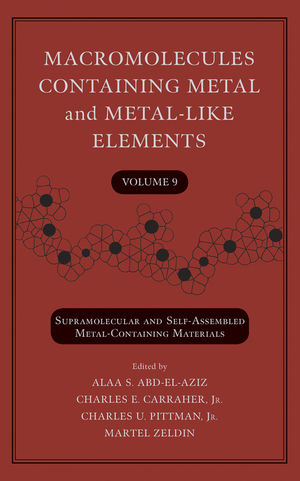Macromolecules Containing Metal and Metal-Like Elements, Volume 9: Supramolecular and Self-Assembled Metal-Containing MaterialsISBN: 978-0-470-25144-7
Hardcover
552 pages
November 2009
 This is a Print-on-Demand title. It will be printed specifically to fill your order. Please allow an additional 15-20 days delivery time. The book is not returnable.
|
||||||
Series Preface.
1. Supramolecular Structures and Functions with Inorganic Building Blocks (Katsuhiko Ariga, Ajayan Vinu, Jonathan P. Hill, Pavuluri Srinivasu, Somobrata Acharya, and Qingmin Ji).
I. Introduction.
II. Hybrid Lipid Thin Films.
III. Layer-by-Layer Assemblies.
IV. Structure Transcription.
V. Functional Mesoporous Hybrids.
VI. Future Perspectives.
VII. Acknowledgments.
VIII. References.
2. Self-Assembly of Hydrophilic Polyoxometalate Macroanions in Dilute Solutions (Melissa L. Kistler, Joe Pigga, and Tianbo Liu).
I. Introduction.
II. Solution Behavior of POM Macroions: Soluble but Still Aggregate.
III. Characterization of the Supramolecular Structures.
IV. Controlling the Blackberry Formation and Blackberry Size by Changing Solvent Quality.
V. Counterion Association around Discrete POM Macroions.
VI. Counterion Condensation around Blackberries.
VII. Identification of the Driving Forces Responsible for the Blackberry Formation.
VIII. Soft Nature of the Blackberries—Effect of Additional Hydrogen Bonding.
IX. Weak Electrolyte Type POMs.
X. Effect of Additional Electrolytes.
XI. Kinetic Process of Blackberry Formation.
XII. Cation Transport over the Anionic Blackberry Membrane.
XIII. Macroions in Solution: An important Linkage among Simple Ions, Polymers, Colloids, and Biosystems.
XIV. Conclusions.
XV. Acknowledgments.
XVI. References.
3. Supramolecular Structures and Polyoxometalates (Samar K. Das).
I. Introduction.
II. Supramolecular Features of Polyoxometalate-Supported Transition-Metal Complexes.
III. Polyoxometalate Crown Ether Complexes with Supramolecular cations.
IV. Supramolecular Water Clusters Associated with Polyoxometalates.
V. Concluding Remarks.
VI. Acknowledgements.
VII. References.
4. Supramolecular Coordination Networks Employing Sulfonate and Phosphonate Linkers: From Layers to Open Structures (George K. H. Shimizu, Jared M. Taylor, and Ramanathan Vaidhyanathan).
I. Introduction.
II. The Sulfonate Group as a Ligand.
III. Layered Metal Sulfonates.
IV. Nonlayered Metal Sulfonates.
A. Dynamic and Crystalline Metal Sulfonate Frameworks.
B. Hydrogen Bonded Second Sphere Coordination Networks.
V. Metal phosphonates.
VI. Conclusion.
VII. References.
5. Transition-Metal-Based Linear Chain Compounds (Moumita Majumdar, and Jitendra K. Bera).
I. Introduction.
II. Ligand-Supported Metal Chains.
A. Linear Chains of Chromium.
B. Linear Metal Chains of Cobalt.
C. Linear Chains of Copper.
D. Linear Chains of Nickel.
E. Linear Chains of Palladium.
III. Unsupported Metal Chains.
A. Linear Chain Compounds of Rhodium.
B. Linear Chain of Iridium.
C. The Platinum Blues.
IV. Concluding Remarks.
V. References.
6. Boronate-Linked Materials: Ranging from Amorphous Assemblies to Highly Structured Networks (Brett M. Rambo, R. William Tilford, Laura M. Lanni, Jie Liu, and John J. Lavigne).
I. Introduction and Scope.
II. Supramolecular Boronate Assemblies.
A. ‘‘Traditional’’ Hydrogen Bonded Supramolecular Assemblies.
B. ‘‘Novel’’ Phenyl-Boron-Phenyl Sandwich Supramolecular Assembly.
C. Coordination-Based Macrocyclic Assemblies.
D. Coordination-Based Linear Assemblies.
III. Covalently Linked Boronate Assemblies.
A. Covalently Linked Macrocyclic and Cage Assemblies.
B. Covalently Linked Linear Assemblies.
C. Covalently Linked Network Assemblies.
IV. Summary and Outlook.
V. References.
7. Mixed-Metal Supramolecular Complexes Coupling Polyazine Light Absorbers and Reactive Metal Centers (Shamindri M. Arachchige, and Karen J. Brewer).
I. Introduction.
A. Light Absorption.
B. Solar Water Splitting.
C. Metal Complexes as DNA Targeting Agents.
D. Supramolecular Charge Transfer Complexes.
E. Cyclic Voltammetry of Charge Transfer Light Absorbers.
II. Supramolecular Complexes Coupling Ru(II) or Os(II) Polyazine Light Absorbers and Rh(III) Reactive Metal Centers.
A. The Complexes [(bpy)2Ru(BL)RhH2(PPh3)2]3+.
B. Cyanide-Bridged Ru(II)-Rh(III) Complexes.
C. Polyazine-Bridged [(bpy)2Ru(dpp)Rh(bPy)2 5+.
D. Tridentate-Bridged Complexes: [(ttpy)Ru(tpy-(Ph)n-tpy) Rh(ttpy)]5+(n=0-2).
E. Ru(II)-Rh(III) Complexes Bridged with a Flexible Spacer: [(Me2phen)2Ru(Mebpy-CH2-CH2-Mebpy)Rh(Me2bpy)2]5+.
F. Dendrimeric Ru(II)/Os(II)-Rh(III) Complexes: [M{(dpp)Rh(ppy)2}3](PF6)5.
G. Extended Supramolecular Architectures with Fe(II)/Ru(II)/Rh(III).
H. Stereochemically Defined Tridentate-Bridged Ru(II)-Rh(III) Complex.
I. Photoinitiated Electron Collection.
III. Supramolecular Complexes Coupling Ru(II) or Os(II) Polyazine Light Absorbers to Reactive Pt(II) Metal Centers.
A. Cyanide-Bridged Ru(II)-Pt(II) Complexes: [(bpy)2(CN)Ru(CN)Pt(dien)](ClO4)2 and [(dien)Pt(NC)(bpy)2Ru(CN)Pt(dien)](ClO4)4 .
B. A Ru(II)-Pt(II) Complex as a Chemodosimeter.
C. Ru(II)-Pt(II) Complexes Bridged by Flexible Spacers.
D. A bpm-Bridged Ru(II)-Pt(II) Complex: [(bpy)2Ru(bpm)PtCl2]2+.
E. Ru(II)-Pt(II) dpp-Bridged Complexes: [(bpy)2Ru(dpp) PtMe2]2+ and [(bpy)2Ru(dpp)PtCl2]2+.
F. Ru(II)-Pt(II) Complexes Bridged by a BL Ligand with Two Inequivalent Sites.
G. DNA Binding of the Ru(II)-Pt(II) Complex: [(tpy)Ru(dtdeg)PtCl]Cl3.
H. Ru(II)-Pt(II) Complexes with Amino Linkages: [(bpy)2Ru(BL)PtCl2](PF6)2 (BL = bpy(CONH (CH2)3NH2)2 and phenNHCO(COOHbpy)).
I. Systematic Studies of Ru(II)/Os(II)-Pt(II) Complexes with Polyazine Bridging Ligands.
J. Dendrimeric Ru(II)-Pt(II) Complexes Bridged by Polyazine Bridging Ligands.
IV. Supramolecular Complexes Coupling Ru(II) Polyazine Light Absorbers to Reactive Pd(II) Metal Centers.
A. Ru(II)-Pd(II) Complexes Bridged by dpp and bpm Ligands: [(bpy)2Ru(dpp)PdCl2](PF6)2 and [(bpy)2Ru(bpm)PdCl2](ClO4)2.
B. Ru(II)-Pd(II) Complexes Bridged by an Extended Polyazine Ligand: [(tBu2bpy)2Ru(tpphz)PdCl2](PF6)2.
C. Ru(II)-Pd(II) Complexes Bridged by bpm type Ligands: [(bpy)2Ru(BL)PdMeCl]2+.
D. A Ru(II)-Pd(II) Complex Bridged by a Flexible Polyazine Bridging Ligand: [(bpy)2Ru(DMB)PdCl2]2+.
V. Conclusions.
VI. Acknowledgments.
VII. References.
8. Supramolecular Hybrid Materials—Integrating Functionality with Sensing (Ramón Martínez-Máñez, Félix Sanceno´n, Ana Belén Descalzo, and Knut Rurack).
I. Introduction.
II. Enhanced Coordination by Preorganization. Surface Chelate Effect and Signaling.
III. Enhanced Signaling by Preorganization.
IV. Assembly-Disassembly.
V. Selectivity by Polarity and Size. Biomimetic Signaling.
VI. Switching, Gating and Signaling.
VII. Conclusions.
VIII. Acknowledgments.
IX. References.
9. Molecular Recognition Process between Nucleobases and Metal-Oxalato Frameworks (Oscar Castillo, Antonio Luque, Juan P. Garcıá-Terán, and Pilar Amo-Ochoa).
I. Introduction.
A. Molecular Recognition.
B. Nucleobases.
C. Oxalate.
II. Metal-Oxalato-Nucleobase Extended Systems.
III. Other metal-nucleobase 1D Extended Systems.
VI. Hybrid Systems Based on Metal-Oxalato and Protonated Nucleobases.
V. Conclusions.
VI. References.
10. Crystal Engineering of Coordination Polymers (Marius Andruh, and Catalina Ruiz-Pérez).
I. Introduction.
II. Synthetic Approaches.
A. The Node-and-Spacer Paradigm.
B. Flexible Ligand Approach: Polycarboxylates as Anionic Linkers. A Case Study—Malonato Complexes.
C. The Building-Block Approach.
III. Conclusions and Perspectives.
IV. Acknowledgments.
V. References.
Index.



